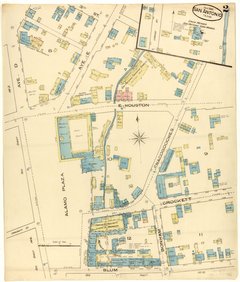The month of October is Texas Archaeology Month, and International Archaeology Day is October 16. Across the state, archaeologists use this month to highlight the valuable information that investigations have produced, as well as bring attention to the state’s rich cultural heritage. Archaeological sites across Texas are amazing resources that can teach us about some of the earliest people who lived here to historic buildings, battle sites, and shipwrecks. This month we bring you a little bit about archaeology at The Alamo through a series of posts.
What is Archaeology?
Archaeology is the scientific study of the human past using material remains. Archaeology is a subdiscipline of anthropology, which is the comparative and holistic study of humanity and human behavior.
The archaeological process roughly follows the scientific method and includes multiple steps:
- Formation of a hypothesis
- Review of options for testing the hypothesis
- Site identification (background and literature research)
- Formulation of research design
- Gathering of data (e.g., survey, excavation)
- Artifact processing and analysis
- Interpretation
- Reporting
- Curation
Archaeologists follow standards, regulations, and an ethical code set forth by the Society for American Archaeology and, in Texas, the Council for Texas Archaeologists. Oversight and compliance are provided by the Texas Historical Commission.
At the Alamo, we mostly practice historical archaeology which is focused on past societies that left behind written documents and histories, often this refers to time periods after the arrival of Europeans. Historical archaeologists utilize documents, maps, and historic photos when interpreting the archaeological record. Since the site has been occupied during both the prehistoric and historical period, we encounter objects that predate the Spanish arrival, as well as see a continuation of indigenous technology into the historical era.
The archaeological record refers to the physical evidence of the past uncovered through archaeological investigations. The archaeological record includes artifacts, features (immovable remains, such as structures or hearths), and even the surrounding landscape. When conducting investigations, archaeologists carefully and meticulously document everything. This means taking copious notes and photographs, producing scaled drawings and maps, and documenting provenience of all cultural materials.
Provenience is the precise physical location of an artifact or feature in three-dimensional space. Provenience is critical in archaeology because the location of artifacts and their context can provide information such as function or temporal significance. For example, an individual stone tool won’t provide a lot of information, but a stone tool found next to a bison bone can tell an archaeologist that bison were hunted and how the tool may have been used by the hunter.
The Alamo archaeologists use a variety of archival records to help inform us to what may be found at the site. One valuable resource used by Alamo archaeologists are the Sanborn Fire Insurance Maps. These maps were published by the Sanborn Map Company and exist for multiple years in various cities throughout the U.S. In San Antonio, the earliest Sanborn maps date to 1877 and, although the Alamo appears on the 1877 map, the first year that provides complete details of the landscape surrounding the Alamo comes from 1885 (see below). The Sanborn maps assist archaeologists in interpreting the archaeological record, especially in downtown San Antonio which has been a hub for commerce, trade, and residence for centuries. Historic structures and their building materials are visible on the Sanborn maps, which aids archaeologists in identifying uncovered foundations.



